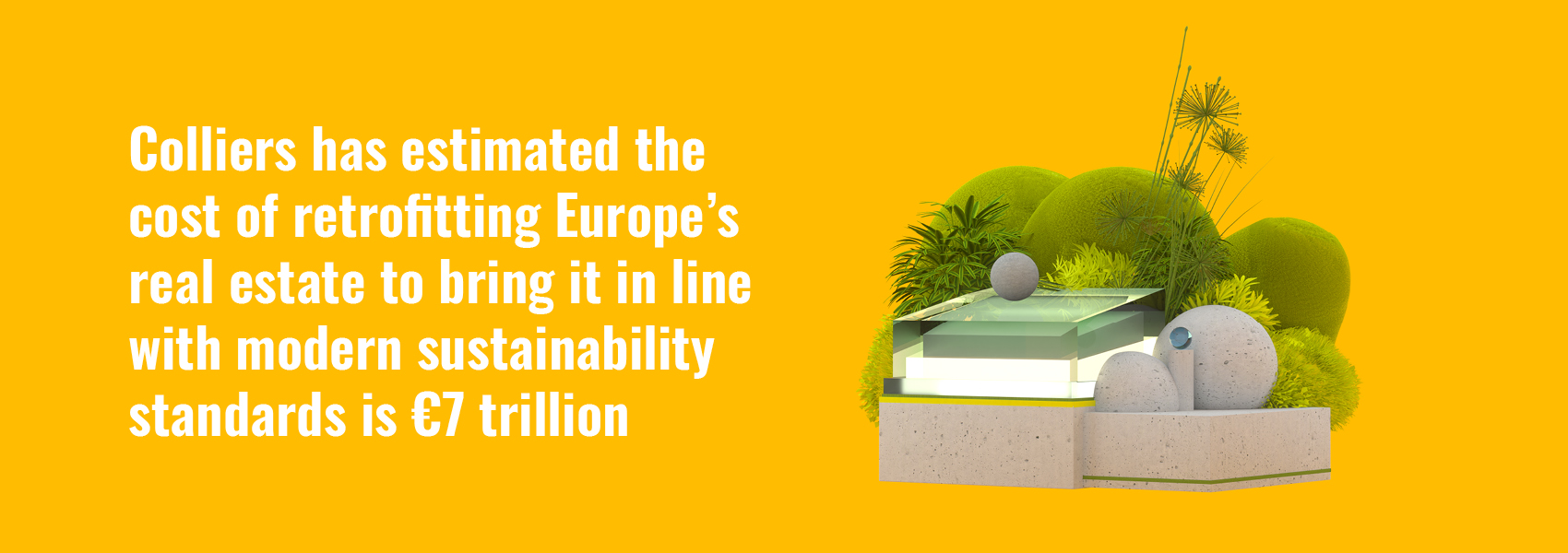
Illustration by Boldtron
The climate agenda is shaping the face of the commercial property world. In the last two years global real estate owners have made net zero commitments in their droves, while regulatory change is sending investors towards greener and more ESG-compliant (environmental, social and governance) property portfolios.
A measurable net zero strategy is now an expected norm – so much so there have been multiple warnings that those without carbon reduction plans could struggle to access equity and debt financing in less than two years. Carbon reduction is beginning to play a major role in preserving the value of commercial property assets and the race is on to cut emissions in every corner of the sector.
“Everything is changing so fast,” says Janine Cole, sustainability and social impact director at GPE, a London-based property investment and development company. Two years ago, GPE took the then unusual step of introducing a voluntary internal carbon price across its £2.5bn central London portfolio. Set at £95 per tonne of CO2, Cole says it’s remained one of the highest in the industry and is basically “a tax on ourselves”.
She says the company reviewed its net zero carbon and sustainability strategy and found it would still have 50% of its emissions left to offset by 2030. “We were really surprised by that,” she recalls. “We had set really challenging targets.” Cole says attaching a number to carbon sends a clear signal of intent and supports overall behaviour change within GPE and its supply chain.
The carbon price covers both operational emissions and embodied carbon, which includes the carbon used to produce building materials. In its developments and refurbishments GPE calculates its expected carbon usages and costs it through its pricing structure. “We know how much that development will pay,” says Cole. “And that’s a huge incentive to drive that figure down. We can already see it working.”
Cole points to GPE’s current 121,800 ft2 office refurbishment at 50 Finsbury Square, London, which is expected to be its first certified net zero carbon building when it completes in the autumn.
International standards in net zero construction
While GPE has set up its own carbon pricing and recording structure, international standards are catching up. In November, the International Cost Management Standard (ICMS) was updated to include carbon pricing and management. ICMS 3 is a reporting format for classifying and measuring carbon emissions throughout the lifecycle of a building from its inception to its end. It’s expected to provide a consistent and transparent reporting structure for developers and investors looking for tangible proof of net zero construction and buildings management.
RICS is one of 49 organisations across the world that have developed the standard and describe it as a “world first” for commercial property. Collecting data that can be compared globally could be a vital move in reducing the carbon footprint of new builds, but what about existing commercial property?
Colliers has estimated the cost of retrofitting Europe’s real estate to bring it in line with modern sustainability standards is €7tr. This, it says, dwarfs the value of its annual real estate transactions at just €300bn and warns that all stakeholders in the market “need to have serious dialogue” about how to transform existing portfolios.

Regulatory change is on the horizon
Back at GPE and Cole says the company is funding its retrofitting programme from the proceeds of its internal carbon pricing, which goes into a decarbonisation fund. This she says is “helping it go faster.” A key factor is the expectation that the UK government will require all commercial property buildings to have an Energy Performance Certificate rating of B by 2030. It’s estimated that 80% to 90% of London’s stock is currently rated C or below, which could have a huge impact on its value with institutional investors in the future.
Cole says she is taking a “building by building” approach on retrofitting but is keenly aware of looming regulatory change. “It is fundamental to be able to let our buildings,” she says. Cole adds that getting data and granular information about the construction and energy performance of its buildings will play a huge part in its strategy. “When we have a detailed profile of a building that’s when we understand it, and that’s when we can see where the interventions are needed. It goes back to using data in an informed way. We all need to get to that point.”
For countries at an earlier stage of their net zero journey, data is proving an invaluable tool to catch up. “Data has opened up our ability to see anomalies and correct our course,” says Anubhav Gupta FRICS, chief sustainability and CSR officer at Mumbai-based Godrej Properties. He points to one of its developments where its electricity use far exceeded its benchmarked norm, only to find the use of high-polluting diesel generators because of power outages.
Gupta has set out a roadmap to achieve net zero emissions in its developments and operations, remain water positive and reduce its waste to landfill. He says through its data programme Godrej will be able to see “how big the elephant really is” and be in a more settled place in the next year. “We may even have solved the tail or one of the legs by then,” he jokes.

Sustainable insurance claims
In Canada, data analysis is also shaping carbon reduction in an entirely different sphere of commercial property – insurance restorations. Construction through insurance claims is a $20bn industry in Canada and after a catastrophe, sustainability is traditionally low on the list in the scramble to rebuild. But a pilot currently being run between engineering firm MBC Group and insurer Aviva aims to reduce carbon emissions in all its claims to net zero by 2040.
Ross Huartt MRICS, CEO of MBC Group pitched the idea of a sustainable claims management system last year. Canada was still reeling from a summer of extreme heat, fires and floods that washed away bridges and roads and effectively cut off Vancouver from the rest of the country. It was a telling example of the power of climate change and Aviva agreed to use the new system in a pilot of 100 claims.
The pilot system creates a process to salvage, demolish and recycle all building materials with the ultimate aim of none going to landfill. Huartt says tracking and monitoring the collection and disposal of building materials is crucial, with one tonne of recycled material equivalent to 662kg of CO2 emissions. He is currently analysing the first data from the pilot and says despite it adding an extra layer on top of the claims process they have had “real buy-in from all the participants” and are seeing some results. “It’s not going to be a magic wand, and this is the first stage, but the butterfly effect could be huge,” says Huartt. He says his company doesn’t have the resources to implement the system across the country and he wants the insurance industry to collaborate and introduce it on a large scale. “This has to be a collective effort,” he says.
Even for those surging ahead on tackling their emissions in commercial property, there is still a massive uphill task if challenging net zero targets are going to be met. With investor and regulatory pressures growing, the whole industry needs to pull together and collaborate if it’s going to have an impact on the carbon footprint of its new and existing property portfolios.


